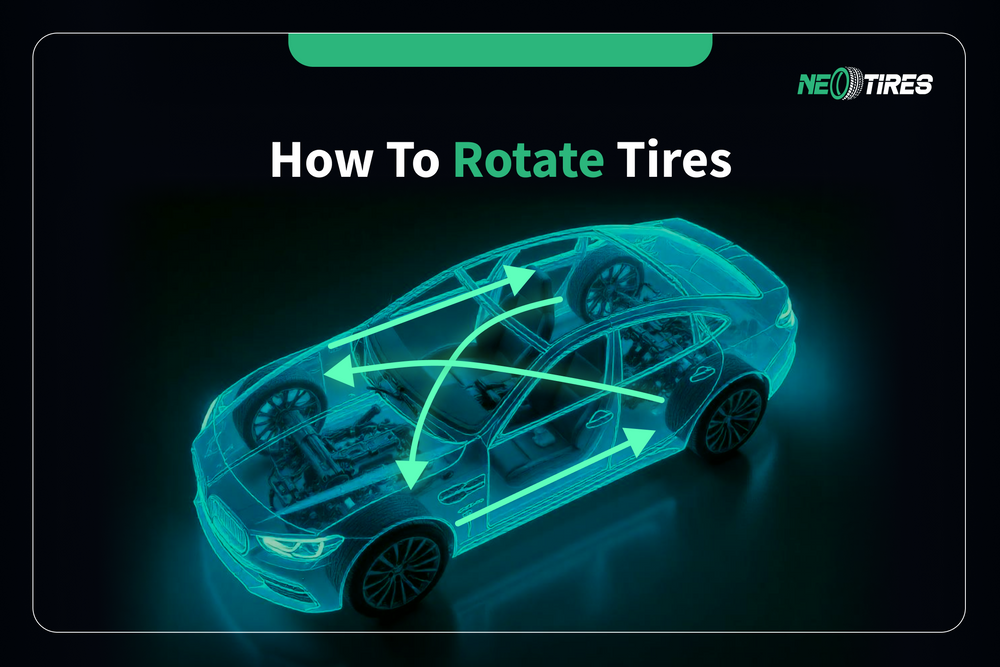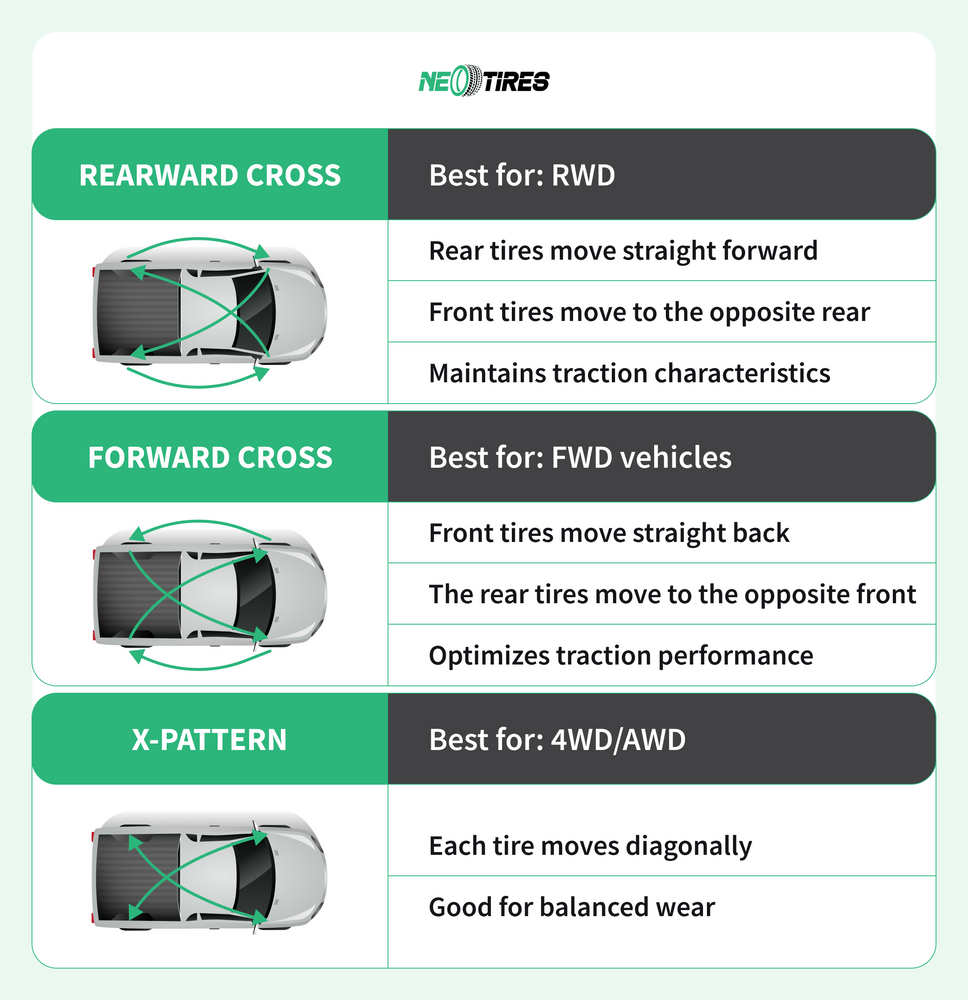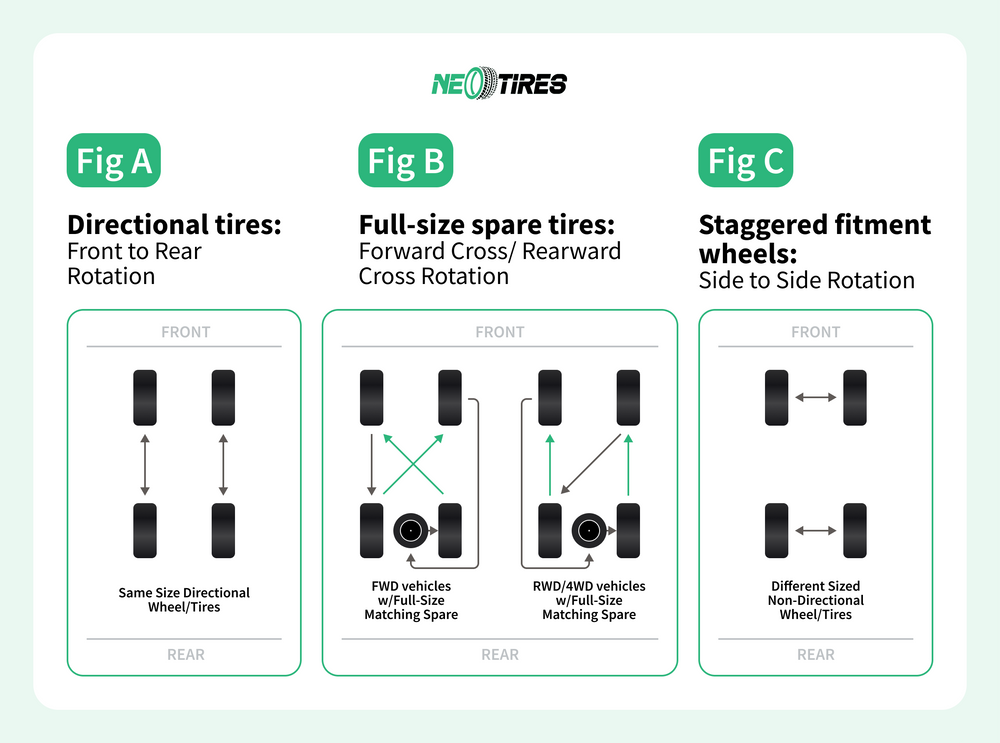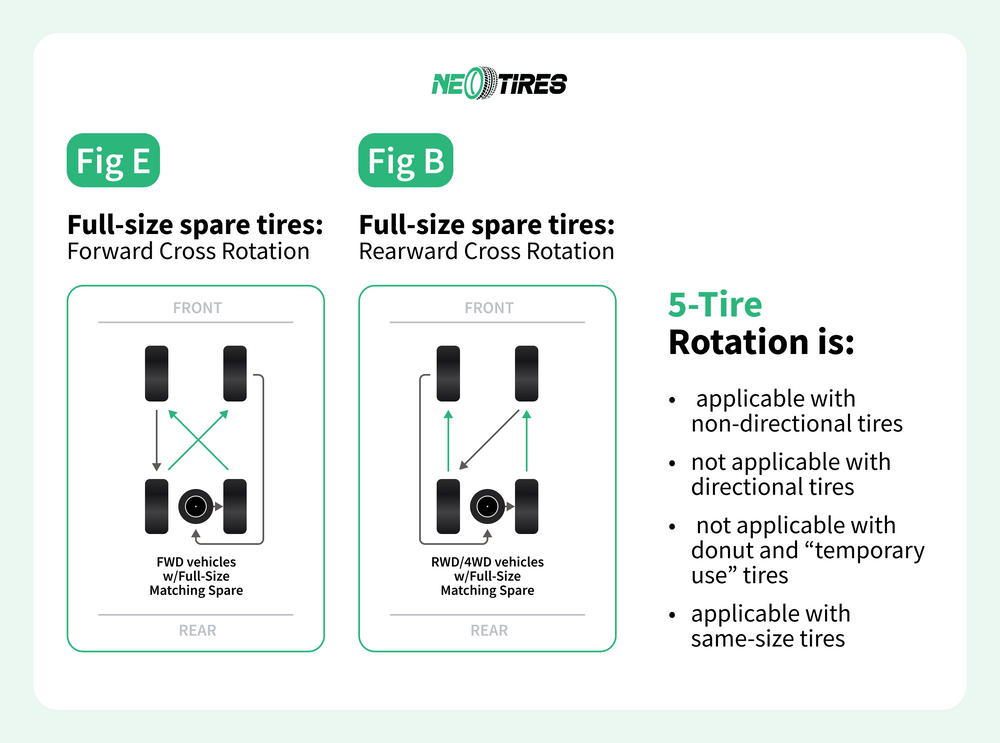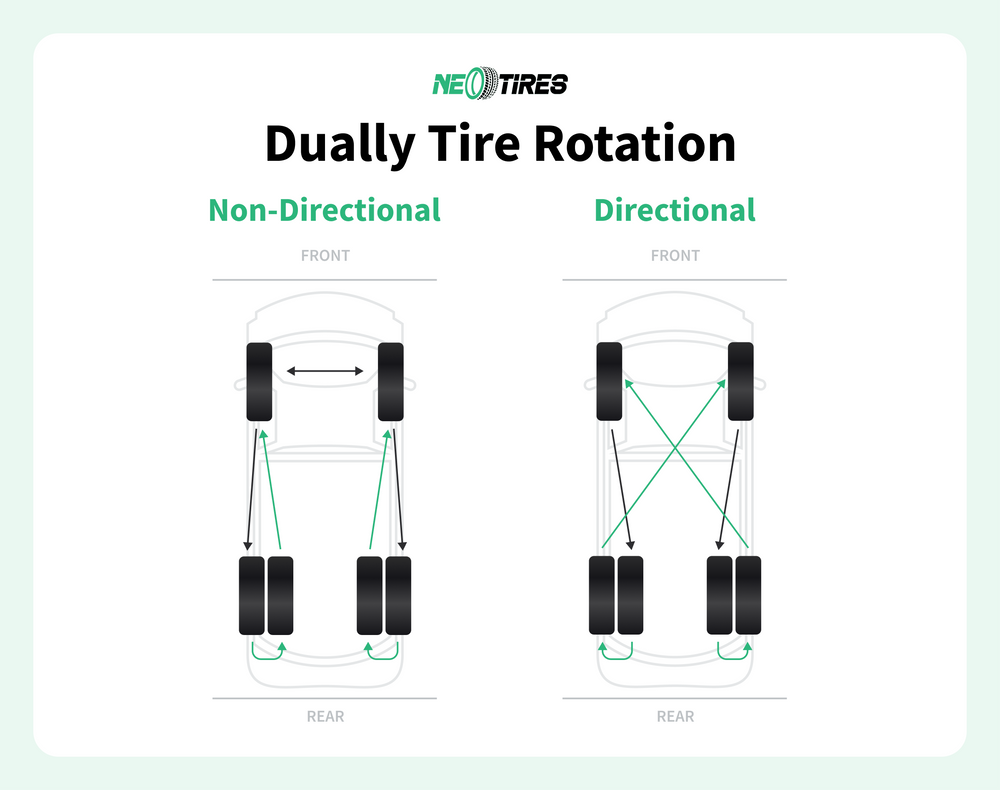Tire rotation is one of those simple maintenance tasks that significantly impacts how long your tires last and how smoothly your vehicle runs. In this guide, we’ll cover everything you need to know, from standard tire rotation patterns (Forward Cross, X, Rearward Cross) to specific setups like staggered, directional, 5-tire, and dually truck rotations. You’ll also learn the right tools to use, what to check after rotation, and when it’s smarter to let professionals take over.
If you prefer learning through visuals, you can watch the YouTube video provided that explains how to rotate tires step-by-step before diving into the detailed guide below. It’s a great way to view the rotation process in action before doing it yourself or going to a service station.
How To Rotate Tires: What You Need To Know
Tire rotation is when all tires change their position between vehicle axles to extend their service life. Different types of vehicles (FWD, RWD, AWD, 4WD) have different tire rotation patterns (Forward cross, X-pattern, Rearward cross). The standard patterns include:
- Forward Cross Rotation
By Forward Cross rotation, the rear tires go diagonally to the front axle while the front tires go directly back without switching sides. This way, the less-worn rear tires can better handle the increased front stress;
- Rearward Cross Rotation
By Rearward Cross rotation, the rear tires move to the front, keeping the same side, while the front tires move to the opposite back (diagonally). This rotation pattern helps optimize stress distribution, especially on the rear tire;
- X Rotation Pattern
The X rotation assumes all tires go diagonally, changing sides while moving from rear to front and vice versa. This pattern helps mitigate the unique wear patterns on AWD and 4WD vehicles.
Standard Rotation Patterns: Forward Cross, X Pattern, Rearward Cross
Tire rotation is different from standard patterns when:
- the spare tire is involved (5-tire rotation)
- using directional tires
- the vehicle has staggered fitment
Directional tires can be rotated only by swapping fronts for rears (Front-to rear) on the same vehicle side (Fig. A). Depending on the drive type, the full spare tire can be rotated in a Forward Cross or Rearward Cross pattern (Fig. B). Staggered fitment wheels can only undergo a Side-to-Side rotation pattern, meaning that tires change places on the same axle only (Fig. C).
b.Tire Rotation with Directional tires, Full-size spare tires, and Staggered Fitment wheels
Tire rotation can be done both at a specialized service station and at home. It’s highly recommended to ensure correct torque, perform tire balancing, check alignment, adjust pressure, reset TPMS, and update service records following the rotation process. This reduces the risks of common problems related to tire rotation, like car shaking, noise, low pressure, lug nuts issues, uneven tread wear, and TPMS false readings.
How Do You Rotate Tires?
Rotate tires in a forward cross pattern for FWD vehicles. Move the front tires to the rear without switching sides and the rear ones to the front in a diagonal pattern. Rotate tires in a rearward pattern for RWD vehicles. Rear tires become the front ones on the same side of the car, while the front should go diagonally to the rear. Apply the X pattern in 4WD and AWD cars, in which all tires move diagonally between axles.
Before rotating tires, understanding vehicle type and the rotation pattern, and ensuring you have all the tools for the process is highly recommended. Rotation can also be scheduled at your nearest service station, where qualified technicians will provide balance, alignment, and TPMS reset if needed.
Understanding the drive system of the vehicle and the type of tires is crucial as they determine the rotation pattern. The Rearward Cross pattern is recommended for rear-wheel drive vehicles, while the Forward Cross best matches the front wheel drive ones, as per Bridgestone. The X pattern is generally applied to 4WD and AWD types of vehicles.
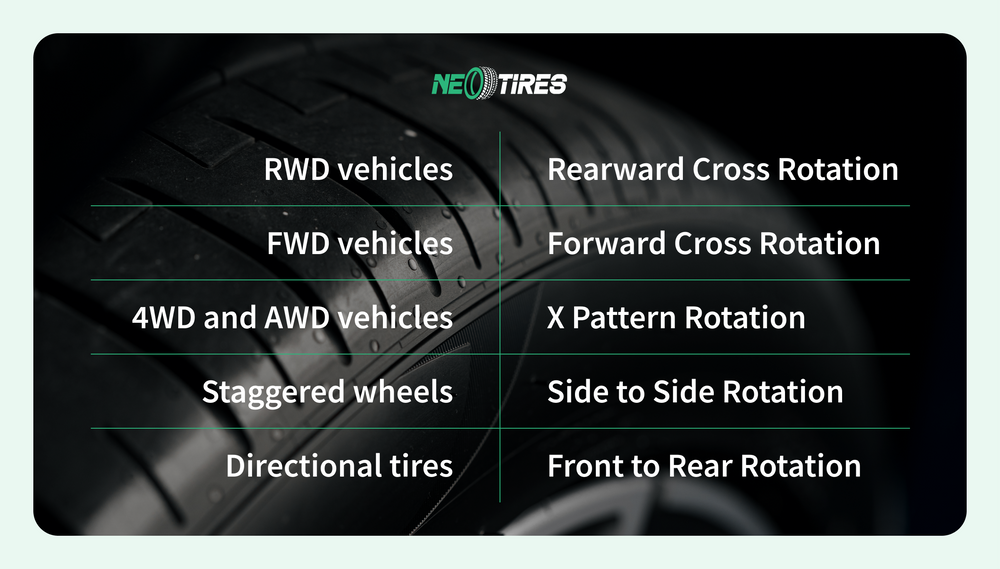
Drivers should always check the type and tire size when performing rotation. Differently sized tires (staggered) on the rear and front axles can only undergo Side-to-Side rotation. Directional tires can only be moved front to back and vice versa while remaining on the same side of the vehicle.
Make sure to have all basic tools if performing rotation at home (jack and jack stand/impact wrench or lug wrench/wheel chocks/torque wrench/tire pressure gauge). Start the process by ensuring the vehicle is well grounded. Keep an eye on ensuring correct torque and tire air level to avoid subsequent issues like low pressure or wheel separation off the vehicle.
How To Rotate Tires On Front-Wheel Drive (FWD) Cars?
In an FWD car, tires generally undergo a Forward cross-rotation pattern. The tires on the rear axle go to the front axle changing sides (diagonally) while the front tires go directly to the back remaining on the same side of the vehicle.
Before rotating tires on an FWD car, consider their sizes and types. The side-by-side pattern should be applied in case of staggered tires.
While the forward cross pattern is an option of choice for symmetrical (standard) tires, the front-to-back pattern is applicable for directional (non-symmetrical with arrows) tires. This means that the right front tire goes directly to the back and the left front- to the left rear. Directional tires must always maintain an arrow direction pointing forward.
Asymmetrical tires in an FWD vehicle should always be checked for their sidewall markings for “Outside” or “Inside”. These can be rotated like symmetrical ones (Forward cross pattern) while keeping marked “Outside” facing outward at all positions.

How To Rotate Tires On Rear-Wheel Drive (RWD) Cars?
Rotate RWD vehicles in a Rearward Cross Pattern. Rear tires go to the front axle while keeping the same side of the vehicle and the front ones go to the rear while changing sides (diagonally).
Before rotating tires on an RWD vehicle, take into account the tire types and sizing. Symmetrical models can use full rearward cross patterns. The directional ones can go straight front-to-back only and must maintain arrow direction (side-to-side rotation not applicable).
You can rotate asymmetrical tires in an RWD vehicle by using the reward cross pattern while always ensuring the “Outside“ marking is facing outward. The side-to-side rotation is applicable in RWD vehicles with staggered fitments.
How To Rotate Tires On All-Wheel Drive (AWD) Cars?
Rotate tires on AWD vehicles in an X pattern. All tires move diagonally between the front and rear axles unless the manufacturer recommends otherwise.
Check the tire type and sizes before rotating tires on an AWD vehicle to ensure the correct pattern. A full X pattern is allowed in symmetrical models while the directional ones should only go front-to-back on the same side. Rotate asymmetrical tires in an X pattern while keeping the “Outside” marking outward. Side-to-side rotation is applicable for staggered tire sizes.
How To Do Tire Rotation For Staggered Fitment?
To do tire rotation for staggered sizes you should always follow the side-by-side pattern. The front right tire goes to the front left and the left rear tire goes to the right.
Staggered tires refer to setups where the rear tires are wider than the front ones (Fig D). One example is the 245 mm (front) vs 275mm (rear). The only pattern assumes the front left tire switching with the front right and the rear left switching with the rear right. The traditional front-to-back rotation is not applicable because of the size difference between the tires.
Rotation with staggered sizes is only possible for non-directional tires, as per PerformanceAutoSpecialists. Directional tires are crafted to perform in the direction appointed on the sidewall only which makes them possible to rotate only front to rear so that the direction does not change. This scheme is not applicable in the case of staggered tires since the tire sizes between front/rear axles are different.
Directional staggered tires can be technically rotated by dismounting and swapping the wheels. But this action is expensive and not recommended for safety reasons.
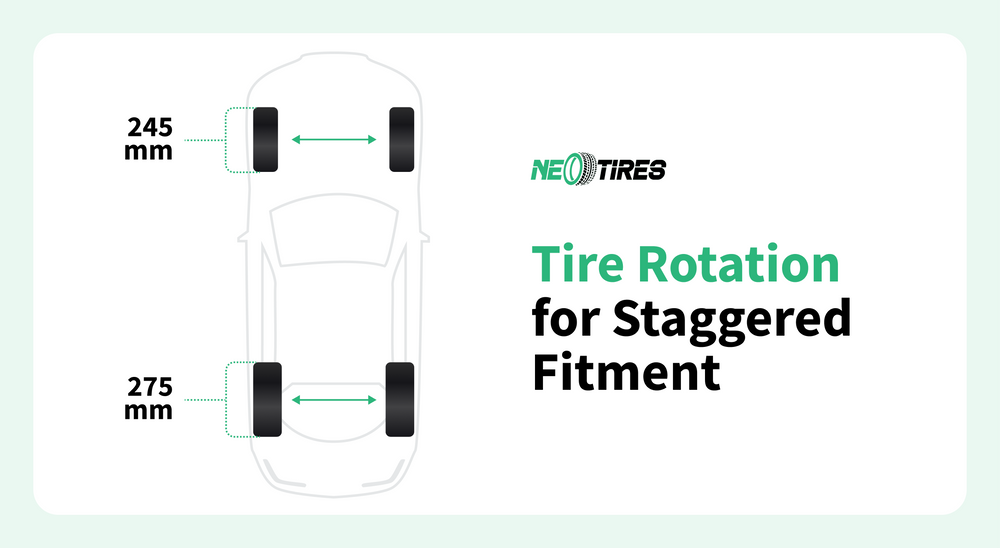
What Is 5-Tire Rotation?
5-tire rotation means including the spare tire (if you have one) in the rotation process along with the 4 basic tires. The 5th spare tire must necessarily be full-size, identical to the 4 tires on your wheels. Donut and "temporary use" spare tires should be excluded from the 5-tire rotation program. This rotation scheme can be performed at home or at a service station guided by a professional.
The 5-tire rotation depends on the type of vehicle. Rotation in FWD vehicles including the full-size matching spare tire assumes the forward cross pattern (Fig E) while the RWD/4WD ones - the rearward cross pattern (Fig B).
Fig E. Full-size spare tire rotation in FWD vehicles. Fig B: Full-size spare tire rotation in RWD/4WD vehicles.
The 5-tire rotation is applicable with non-directional tires. The program is not recommended for directional tires as they are rim-dependent and are designed to work only in one direction. These tires can go front to back on the same side of the vehicle only excluding the crossing to the opposite side. This limitation makes directional tires unsuitable for 5-tire rotation making it useful only for emergency cases.
By 5-tire rotation, all tires wear at a similar rate, maintaining a balanced tread pattern across all tires. A rotated non-directional spare tire is safer to drive than rotating only four and keeping the spare aside.
How To Do a 5-Tire Rotation?
To do a 5-tire rotation, follow the “crossed pentagon” pattern which assumes moving the front right tire to the left rear, the left rear becomes the spare, the spare tire goes to the rear right, the rear right becomes the front left, while the front left takes the place of the front right tire. Check the manufacturer’s recommendations based on the FWD/RWD/AWD/4WD drivetrain.
5-Tire Rotation Pattern
Consider the following 5-tire rotation schemes according to the vehicle drivetrain if the manufacturer doesn't recommend otherwise:
- 5-Tire rotation in FWD vehicles:
->The front left tire goes to the rear left position;
->Front left tire goes to the rear left position;
->The front right tire goes to the rear right position;
->Rear left tire goes to the spare position;
->The rear right tire goes to the front left position;
->Spare tire goes in the front right position.
- 5-Tire Rotation in RWD Vehicles:
->The rear left tire goes to the front left position;
->The rear right tire goes to the front right position;
->The front left tire goes to the spare position;
->The front right tire goes to the rear left position;
->The spare goes in the rear right position.
- 5-Tire Rotation in AWD Vehicles:
->The spare tire goes to the right rear position;
->The rear right tire goes to the front left position;
->The front left tire goes to the rear left position;
->The rear left tire goes to the front right position;
->The front right tire goes in the spare position.
Prepare The Tools
To perform a 5-tire rotation process at home, you will need a jack, lug wrench, pressure gauge, and torque wrench. Set the vehicle in a safe place, ensure the parking brake, and loosen the lug nuts on each wheel before jacking up the car.
5-Tire Rotation Process
Raise the vehicle with the jack only high enough to remove the tires one by one. Apply the rotation pattern according to your vehicle's drive type, putting each tire in its new position. Hand-tighten the lug nuts after placing each tire. Put the car back on the ground and tighten the lug nuts with a torque wrench to the recommended torque setting. Use a pressure gauge to ensure all tires, including the spare one, have the appropriate air level. Keep a record of the process to know when to perform future rotations.
You can similarly address the process to your nearest service station. Mechanics will apply the correct 5-tire rotation pattern along with balance and alignment if needed.
How To Rotate Tires On Dually Trucks (6 Tires)?
To rotate tires on dually trucks, follow the circular rotation pattern in which the front tire becomes the outer rear while the outer rear becomes the inner rear. The inner rear will take the place of the front tire. This triangle scheme is applicable for both sides of the vehicle and includes the rotation of all six tires.
A dually truck refers to a vehicle type featuring two rear wheels on each side so that the vehicle has six wheels overall (standard two on the front axle and four on the back). Otherwise known as DRW, dually trucks need rotation to even treadwear and weight distribution as they are exposed to towing, farming, and heavy loads.
Rotation Process On Dually Trucks
- Rotation of Non-Directional Tires On Dually Trucks
Follow this guideline to perform rotation with non-directional tires on dually trucks:
Right (passenger's) Side of the Dually Truck:
->The front right tire becomes the outer right rear tire
->The outer right rear tire becomes the inner right rear tire
->The inner rear tire becomes the front tire
Left (driver's) Side of the Dually Truck:
->The front tire becomes the outer left rear tire
->The outer left rear tire becomes the inner left rear tire
->The inner left rear tire goes to the front driver's side position
- Rotation of Directional Tires On Dually Trucks
Directional tires are meant to rotate in one direction only, and incorrect rotation might bring about improper water evacuation out of their way. Consider the guideline below for directional tires on dually trucks unless the manufacturer recommends otherwise:
->The front (driver's side) tire goes to the inner left rear position;
->The inner left rear tire becomes the outer left rear tire;
->The outer left rear tire takes the place of the front passenger's side position;
->The front (passenger's) tire goes to the inner right rear position;
->The inner right rear tire becomes the outer right rear tire;
->The outer right rear tire becomes the front driver's position
Directional and Non-Directional tire rotation in dually truck vehicles
How To Do Tire Rotation At Home?
- To perform rotation at home, you will need a car jack, jack stands (minimum 2, optimal 4), a lug wrench, wheel chocks (in case of inclined position), and a pressure gauge. Identify the rotation pattern that depends on your tire and vehicle drive types.
- Use the forward cross pattern for FWD vehicles and the rearward cross pattern for RWD ones. AWD and 4WD shall follow the X-cross pattern as recommended by Bridgestone. These schemes are typically applicable for non-directional tires that can roll in either direction.
- Directional tires can follow the front-to-back rotation pattern only due to their specific pattern. Check and ensure that the arrow on the sidewall always follows the rotational direction during the rotation process.
- Loosen the lug nuts and jack up your car with the jack stands to support your car. Carefully remove the tires and rotate them according to the correct pattern. Screw in the lug nuts by hand and remove the jack stands carefully. Lower your car back on the ground and fully tighten the lug nuts using the lug wrench. Ensure proper torque as recommended by the manufacturer to avoid issues like wheel detachment, uneven tire wear, brake system damage, or noise and vibrations. Finish the process by checking and adjusting pressure, if applicable, across all four tires.
Which Tools Are Required to Do Tire Rotation at Home?
Use these five tools to perform tire rotation at home: jack/jack stands, lug wrench (or impact wrench), wheel chocks (especially needed when performing rotation on an inclined surface), torque wrench (or torque stick), and tire pressure gauge to ensure proper air inflation across all tires.
Is DIY Tire Rotation Better Than Professional Rotation?
No, DIY tire rotation is not more beneficial than the professional process as it depends on influencing factors such as experience, tools, dexterity, and attention to detail. DIY rotation might be convenient as it is cost-saving and you can do it anytime. Still, it might be risky from a safety perspective (not torquing the lug nuts properly, for instance) in case of poor experience.
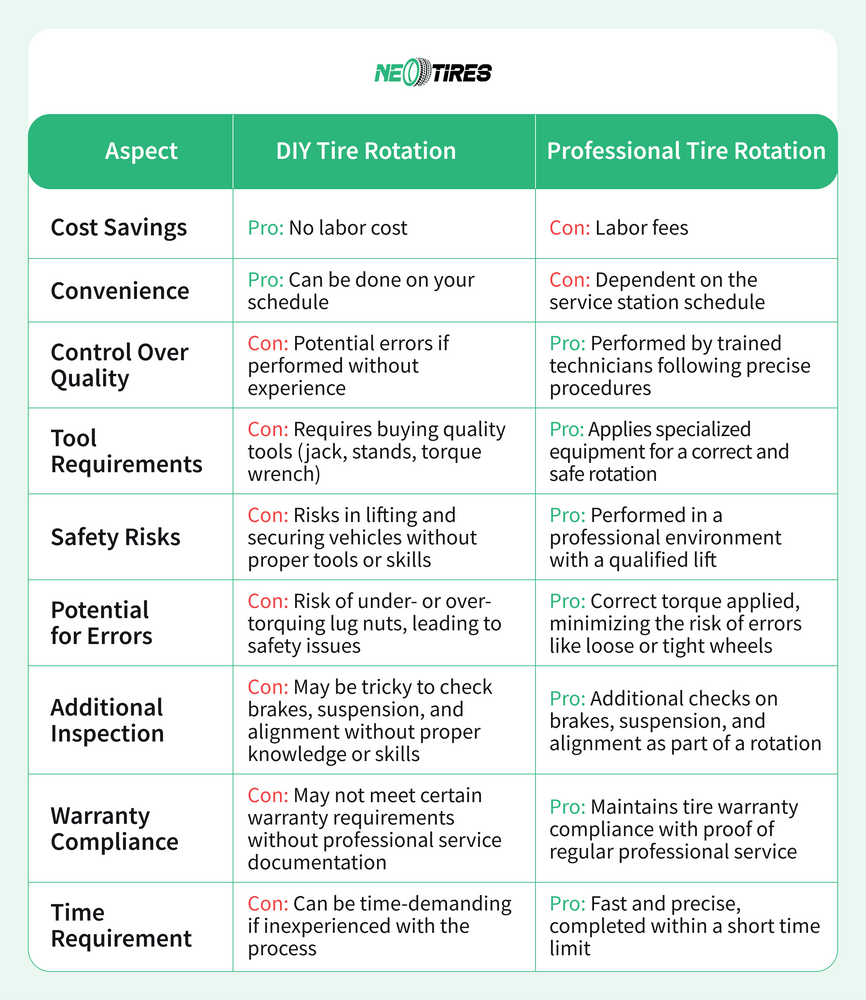
What Are The Six Things To Ensure After Tire Rotation?
The following six things should be ensured to make the most out of the rotation procedure:
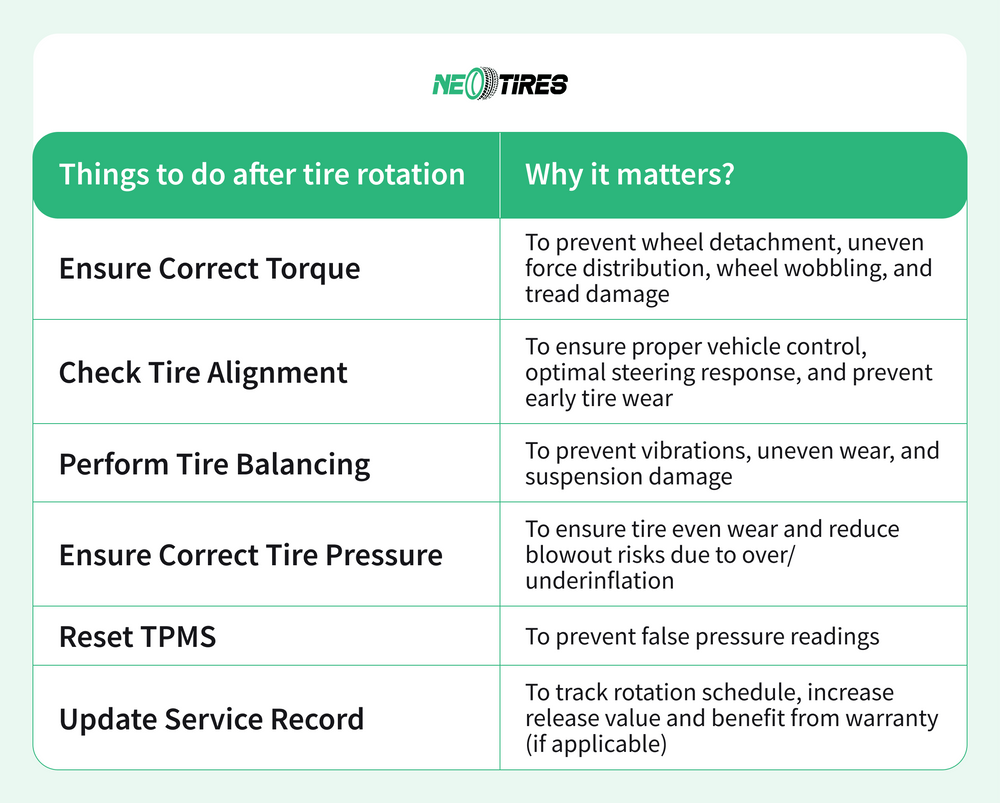
Can Problems Happen After Tire Rotation?
Yes, seven common issues might appear following rotation, including tire noise, car shaking, low tire pressure, loose or over-tightened nuts, traction loss, TPMS malfunction, and uneven wear.
For tire rotation pricing, check our full article How Much Does Tire Rotation Cost?
Rotate Smarter, Drive Longer with NeoTires
Regular tire rotation is an effective maintenance procedure to ensure even tire wear and optimal performance. Keeping up with rotations makes a big difference. If tire replacement is a wiser option than rotation (due to tire age or worn-out tread), NeoTires has what you need! Looking for tires that last? Browse our collection or ask our experts for the best options. Drive safe and choose your tires wisely!




